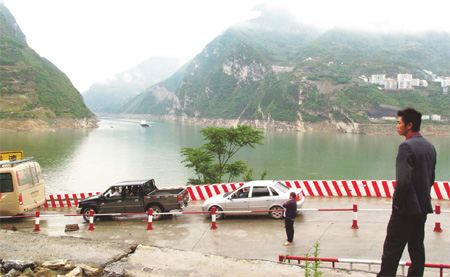Society
Life behind the Three Gorges Dam
Updated: 2011-06-03 07:49
By Hu Yinan (China Daily)
With limited access to arable land and transportation, opportunities are scarce in the shadow of the great project, Hu Yinan reports from Zigui in Hubei province.
For years, Wang Xiaoyun, 42, has not felt like venturing outside her hometown in central Hubei province. There is nowhere to go.
As she sits all day on a low stool in a roadside grocery store, she hopes for an occasional passer-by on her side of the deep Xiangxi River.
Wang fondly remembers when the river was so shallow that she could walk across it as an 11-year-old. But the landscape that gave rise to those memories is gone.
Guizhou town, the seat of Zigui county until 1998, was submerged in 2003 when the area behind the Three Gorges Dam became a lake. Zigui's new county seat, Maoping, is nearby, just west of the dam. About 100,000 people were relocated here (40,000 from Guizhou alone), and the Xiangxi River now runs about 15 meters deep.
The Three Gorges Dam, the world's largest hydroelectric project, covers 20 districts and counties along the Yangtze River and affects a population of 29.4 million.
This is a vulnerable crowd. Eleven of the localities were recognized by the State as "particularly poor" in 2002. The reservoir area's per capita GDP was only 40 percent of the national average, according to the Chongqing Migration Bureau.
On May 18, the State Council, China's cabinet, announced for the first time that "problems that demand prompt solutions exist" in the project's resettlement of residents, ecological protection, and prevention and control of geological disasters. The project's follow-up plan says that by 2020, those resettled as a result of the dam should expect to live the average life of residents in Hubei province and Chongqing municipality, which the reservoir spans.
About 1.3 million people have been resettled since 1993, fewer than 20 percent of them outside the reservoir area. The rest had to move to higher ground. The plots there are smaller and, because the slopes are unstable, most are ill suited to farming.
With limited access to arable land, compensation, preferential policies, education and transportation, many are still struggling in sheer poverty.
Idea dates to 1918
 |
|
Li Yuxiu (second from left) and her husband, Wu Chengqiang (center), outside the shanty they cobbled together in Xiangjiadian village. They had to move out of their crumbling home, which was two meters above the Three Gorges Dam's 175-meter storage level. Hu Yinan / China Daily |
Debates about possible impacts of the dam on nature and the conditions of those who had lived in its footprint have been intense. But for a river that flooded in almost every decade in the 2,000 years of China's feudal history, most scientists agreed that something had to be done.
First proposed by Dr Sun Yat-sen in 1918, the idea of the Three Gorges Dam inspired generations of youths in the following decades. Designing the dam was once a career goal for Ma Ho-ling, father of Taiwan's current leader, Ma Ying-jeou. (The elder Ma instead became a senior cadre of the Kuomintang.)
The dam was to be jointly designed by Chinese and US experts as part of an agreement in 1946; US dam expert John Lucian Savage had already conducted field research. But the project was halted in May 1947 by the civil war and the dam's planning did not resume until 1955.
Feasibility studies went on for 37 years. The top national legislative body approved the project in 1992. The water level behind the dam reached 135 meters in 2003 and 175 meters in 2009, when the dam became fully operational. It is seen as a solution to China's flood control and energy production problems.
Until June 10, the Three Gorges Dam is releasing water at up to 12,000 cubic meters a second for drought relief downstream.
"The sudden increase of water discharges from the dam will crash the bank, making the shores unstable," said Guan Fengjun, director of the geological environment department under the Ministry of Land and Resources. The risk of landslides rises, too.
Little arable land
Living conditions of the resettled populations are a major issue. The State's latest goals are for them to catch up with the living standards of the average resident in their provinces by 2020, and that is no easy task.
Hubei and Chongqing aim to boost per capita GDP to $3,400 and $3,300, respectively, by 2020. The numbers fall well short of the national goal, $5,000. The situation is more severe in Zigui, which is classified as a "State-level poor county".
There are no strangers to sacrifice in this county. Zigui's three most famous historic figures are a statesman who drowned himself to protest corruption in the Kingdom of Chu (Qu Yuan, 340-278 BC, the Dragon Boat Festival character), a beauty who married an ethnic chieftain in exchange for peace in the Han Empire (Wang Zhaojun, who was born around 2,000 years ago), and a Communist whose death inspired the Chinese revolution (Xia Minghan, 1900-1928).
Zigui remains underdeveloped, and its people continue to make sacrifices for the dam.
In Guizhou town, the per capita net income was $462 in 2010. At $1.26 a day, this is below the poverty line defined by the United Nations Development Programme ($1.50 a day).
Farmland shortages are at the heart of the problem. Each resettled rural resident here is entitled to 0.05 hectare of arable land, mostly dispersed on fragile hilltops, official statistics show. That is just over half of the national per capita average of 0.092 hectare for the plots that peasants are entitled to farm.
Since 2006, the State has offered monthly subsidies of 50 yuan per farmer for 20 years for those living below the dam's storage level of 175 meters. The money, roughly $7.70 a month, is not enough for three Big Mac meals at McDonald's.
Consequently, many people have left for more profitable jobs in the cities. In Guizhou, 85 percent of adult laborers were working away from home last year.
Dozens of families in Xiangjiadian, a village in Guizhou, complain of insufficient compensation for relocation in 1997 to make way for a road as part of the dam project. Officials paid them 45 yuan per square meter; the land is now worth more than 40 times that. The families lived for five years in shanties they built until the road was completed and they were allowed to build permanent homes beside it.
"We haven't been able to benefit from the policies that official documents stipulate. This has led to my economic losses," farmer Wu Chengcai, 62, said.
E-paper

Tapping into the future
Foreign companies are investing in China's water industry as many predict a growing profit margin.
Preview of the coming issue
Headhunters ride on growth
Commercial property rides wave
Specials

Cuisine central
London's Chinatown is helping diners appreciate full palate of Chinese food

Tying the knot
Danish couple's high-end macrame export business takes off in the mountains of Yunnan.

Truly a super woman
Li Yuchun first came to prominence in 2005 as the Super Girl winner, and since then has become an international star.





